Mr. Paolo BRONZI
Aquaculture was derived from fishing techniques carried out in a confined natural environment, where the techniques employed became more and more sophisticated.
At the beginning, fishing took place in a sheltered environment, like a reserve for hunting where neither the control operations on the water quality nor the prophylaxis or therapy methods against pathologies were nor carried out. It was simply a matter of stocking up with young fish captured in open waters ; feed, if provided, was only natural fodder, and the animals grew in mixed populations without size selections.
Such enterprises were necessarily connected to particular environmental situations of favourable characteristics, such as restricted and hydrologically controlable environments, where little work was required.
An increase of human intervention was soon remarked in the structuration of environments and management, mainly for the administration food and the control of the water flow.
Later on the growing demand of products, brough about a greater and greater industrialization of the productive systems with a consequent release from the natural situation and greater human presence.
The development of artificial reproduction methods has been fundamental, since it provided fingerlings to breeding size, releasing the productive systems from fishing.
In this way, aquaculture becomes more industrialized, creating artificial environments, with pumping systems and quality controls of the water, fingerling productions, food formulation and with a more mass utilisation of technologies and authomatisms in management operations.
However, we are still at an “agriculture” level, even though advanced, since there's no possibility to control completely the production cycles, according to the demand. The concern in fact thermic trends.
The temperature of the water is therefore one of the most important environmental factors, because it controls the whole life of aquatic organisms that are heterotherm, which means that they haven't a stable body temperature, but assume the temperature of the water surrounding them.
The temperature relationships for fish may be summarized as seen in Fig. 1, where the outside line represents the extreme values of temperature that the fish can tolerate. As all the other values of temperature (resistance, tolerance, etc… ) the upper and lower lethal limits increase with the rise in the acclimation temperature.
The second line represents the extreme values of temperature that the fish can withstand indefinitely; in the zone of tolerance the fish withstand different levels of stress that can reduce their growth rate and food conversion efficiency.
The area where the reproduction is possible indicates the thermal values that don't cause any stress.
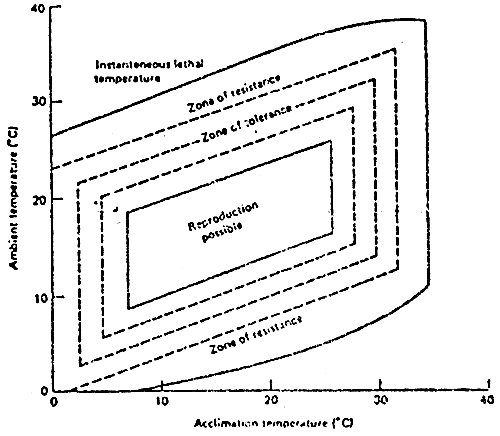
Fig. Schematic temperature relation diagram for a fish.
(From WHEATON, 1977)
If we use oxygen consumption to measure the metabolism, standard and active, we find that if the temperature increases, between a definite range, both metabolisms will increase of course (Fig. 2).
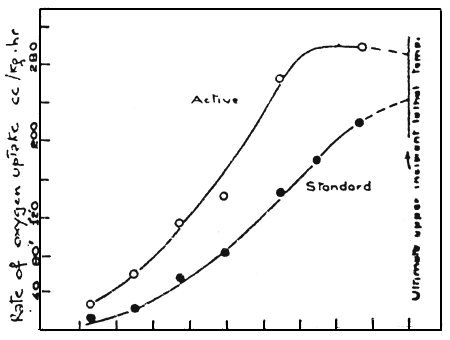
Fig. 2. Active and Standard oxygen consumption curves for goldfish.
(From FRY and HART, 1946).
Standard consumption is the oxygen needed to maintain the basic metabolic rate; the active oxygen comprises the standard rate plus that necessary for the activity in general. The difference between active and standard consumption can be a measure of the oxygen available to support the activity at any temperature (Fig. 3).
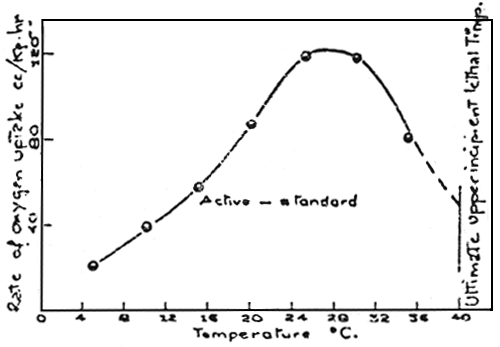
Fig. 3. Difference between active and standard oxygen consumption curves for goldfish (From FRY and HART, 1946).
The direct influence of temperature on growth and on food consumption is of great interest to the aquaculturist. Fig. 4 shows an example of the influence of temperature on the growth rate of a fish. The growth rate increase as the temperature increase until a determined value is reached (27.5° C in the example) then the growth rate decreases.

Fig. 4. Growth rate of largemouth bass fry at different temperatures
(From STRAWN, 1961)
This means that there is an optimum temperature for the growth rate; at higher values, the growth rate decreases.
These considerations are useful if the food, as in nature, is taken ad libitum but when we consider aquaculture plant, we must take into account the combined effects of temperature and food ratio.
Fig. 5 shows the data From BRETT on the effects that the amount of food has on the relationship between the growth rate and temperature for sockeye salmon
It can be remarked that:
- the best growth is obtained with food in excess;
- at any feeding level, there is an optimum temperature for growth;
- if the feeding level is reduced, the optimum temperature of growth decreases;
- if the Feeding level is reduced, the growth rate at all temperatures decreases ;
- there is no growth or loss of weight near the upper lethal temperature.

Fig. 5. Effect that the amount of feed has on the relationship between the
growth rate and the temperature for sockeye salmon
(From BRETT et al., 1969)
But the aquaculturist is interested in the cost of the production and not specifically in the growth rate.
Fig. 6 considers an efficiency curve imposed on the growth rate curves.
Gross conversion efficiency is calculated as:

From the following diagram, we can see that the gross conversion efficiency ranges from 0 to 25 % and that the best results are obtained at 12° C (this level of temperature is lower than the optimum temperature for the best growth, which is 14.5° C) with a feeding of about 4.5 % of the weight per day, obtaining a specific growth rate of 1%/day.
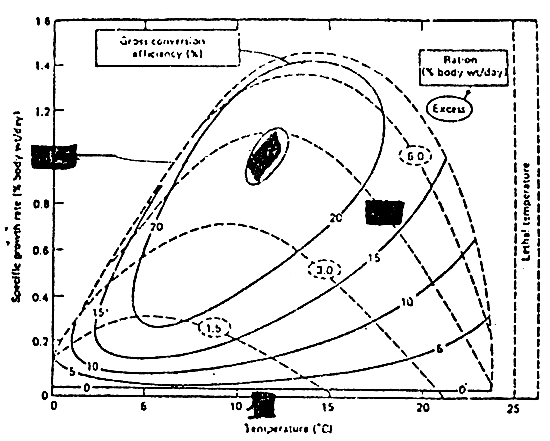
Fig. 6. Gross efficiency of food conversion in relation to temperature and ratio (From BRETT et al., 1969)
This means that for every species, two combinations of temperature and feeding level exit, that produce either maximum gross efficiency of food conversion or maximum growth.
In general the aquaculturist can vary the water temperature between the optimum for growth and the optimum for conversion efficiency, depending on the availability of feed or the need to speed growth.
But we can see that the growth obtainable at the temperature and ratio for the best growth is quite similar to that obtainable at the temperature of the best conversion efficiency by increasing only the food ratio. The best condition therefore is to maintain the temperature of the water at the value for the best conversion efficiency, and to vary the food ratio in order to obtain the best economic result, taking into due account both the cost of food and the cost of the management of the plant.
The possibility to control temperature parameters allows a further development in the industrialization of aquaculture.
Aquaculture in a thermically controlled environment allows as a matter of fact not only a growth-rate increase and a better conversion factor of the food, but, most of all, it permits the control of rhythms and time in order to optimize the utilization coefficients of the structure and of water supply and so the economic productivity of the plant.
Therefore, it is possible to employ in aquaculture the following management criteria:
1) Culture Turnover:
This concerns the breeding of species which prefer either warm water or cold water. This is possible in thermal aquaculture, mainly in fresh water, since at our latitude, the ranges of optimal temperature for the growth of these two fish categories are available.
2) Shift of productive cycles:
During the year, different production cycles may be started, beginning with reproduced fingerlings up to commercial size fish.
This is possible due to water temperature which are available and suitable for the whole year of breeding, and this involves a rotation use of the tanks with a consequent optimization of the utilization coefficient for the water supply and the breeding environments.
3) Dividing production:
This considers in only developing all the productive methods, those phases which can benefit must from thermic control. This involves, for instance, the production of intermediate stages, when they represent the highest production possible for the available condition, leaving the fattening operations to conventional systems where costs are lower. This creates the possibility of integrating different systems of production.
4) Coordination between demand and offer:
Thermal aquaculture permits production to commercial size outside the natural season, when the market demands is high and the offer is low, and in this way, it allows to obtain good selling prices.
The most important and characteristic of these management criteria, permitted mainly by thermal aquaculture, is the shift of the productive cycle.
To show the advantage obtained in this way, let us compare two different hypothesis, the first in conventional conditions and the second in thermal aquaculture.
In the first hypothesis we use conventional management criteria, and we assume that the final commercial size is to be obtained while starting with fingerlings kept in the same breeding tank.
It is presumed that the first breeding cycle has been completed when the second one starts (Fig. 7).
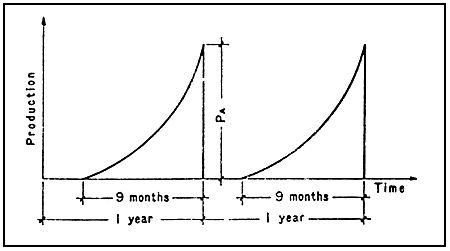
Fig. 7. Annual production: conventional aquaculture
In this case the annual production is:

where:
PFC = Final production (kg/year)
Q = Water supply (m/hr)
r = specific water requirements (dm/hr.kg)
SB max = Stocking biomass (kg)
In this case the hatchery, following the natural biological rhythms, must produce, all at once, the entire fingerling requirement of the whole system, and is therefore used only once a year.
In thermal aquaculture it has been supposed that the commercial size can be reached is a shorter time, approximately 2/3 (two thirds) of conventional time.
As a matter of fact in this case the temperature trends allow breeding to take place practically throughout the whole year, but with different rates of growth, according to the temperature of the season ; the period of 8 months is a mean value for use in our calculations.
Thanks to the possibility to control temperature, it is possible to shift the start of each production cycle, producing the fingerlings required for every fattening period.
If we suppose a shift of 4 months between fattening cycles, and by taking the quantity of water supply that limits the maximum biomass possible in the system at any time as constant, the biomass is obtained by adding animals of different size present in the system at any given time (Fig. 8)
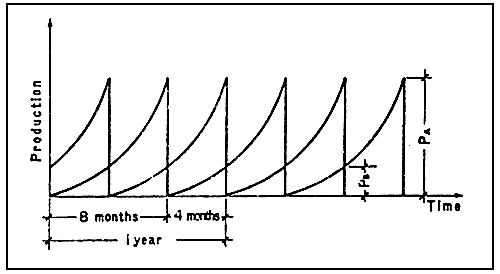
Fig. 8. Annual production : thermal aquaculture
The production of each breeding cycle PA is therefore less than SB max, since:
SB max = PA + PB
where : PB is the biomass of the shifted growing population at the moment when the cycle PA is harvested.
Assuming from experimental data that :
PB = 25 % PA
We get :
SB max = PA + 25% PA
SB max = 1.25 PA

However, since the annual production in the case of n cycles is equal to n times the production of the cycle PA, i.e. :
PFT = n PA
we get :

In the example, n = 3, so :

Deriving from this, the ratio between the annual production in both these cases here, we can obtain:

from which:
PFT = 2.4. PFC
If n increases further, the annual production increases too, and as a result the utilization coefficient of the structures also increases.
The increases, however, steadily decline, whereas the cost of starting a new cycle can be taken as constant.
All this implies that there exists an optimum number of cycles per annum, the exact definition of which will depend on the economic and managerial factors.
It is therefore clear that the possibility of shifting the production cycles offered by thermal aquaculture, not only leaves the time needed to achieve commercial sizes, but also has undoubted advantages in terms of production and management for both the growing and reproduction structures.
In marine aquaculture, the time needed to reach commercial size takes normally more than one year, and the previous considerations must be slightly modified.
If the remark the growth in different rearing conditions (Fig. 11), we can observe that in good thermal conditions, with warmed water, the first commercial size of 250 g can be obtained in 14–15 months.
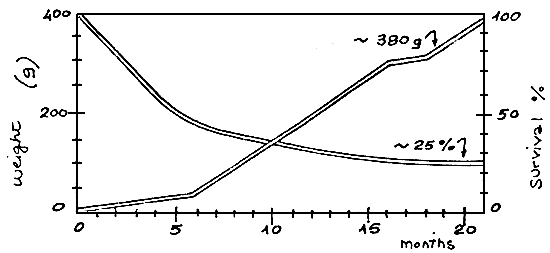
Intensive rearing in warmed recycled water (18 – 20° C)

Intensive rearing in natural waters (7° C during the winter)
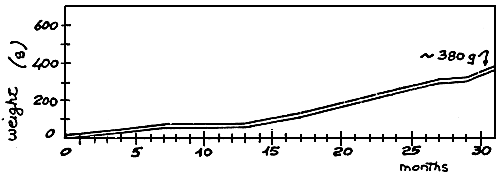
Extensive rearing in natural waters
Fig. 11. Comparison between the growth of sea-bass (Dicentrarchus labrax L)
in different rearing systems
(From RAVAGNAN, 1978)
Considering that in sea-water, the temperature of the water discharged by the power station is also suitable for growth in the Winter period, and that the use of warmed water in the hatchery makes it possible to accelerate the growth of the fry, and that warmed waters during the year generally accelerate the growth of fish, it can be assumed that commercial size is reached within one year.
In thus way, we use year after year, the same tanks and hatchery.
If reproduction is carried out, we can obtain at the same age of life the situation shown in Fig. 12.
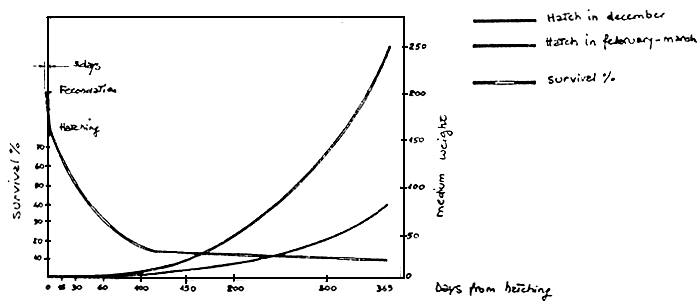
Fig.12. Growth and survival of Dicentrarchus labrax, up to one year.
The same situation is shown in fig.13, where the "top" population. reproduced and selected for size early is comprised of the "heads" and compared to a mixed population conventionally reproduced.
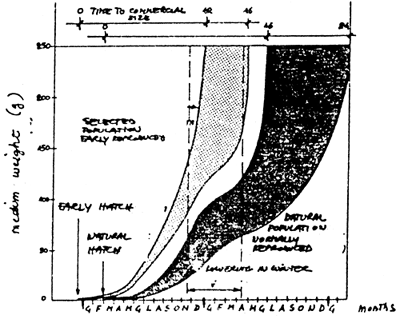
Fig.13. Growth of population of Dicentrarchus labrax with different reproduction periods reared in a thermal fish farm.
Fig.14. Compares the trends of growth up to 500 g of a selected population, reproduced early and reared in thermal aquaculture; an analogous population but conventionally reproduced, and a population of conventional aquaculture.
It is also evident, in the case when the time needed to reach the final size is over a year, that it is advantageous to shorten the time of permanence of animals in the tanks, particularly in thermal aquaculture, where, the costs of building and management are high.
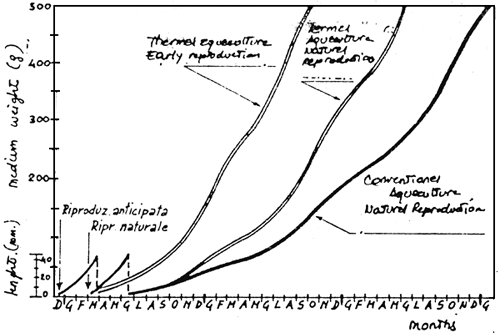
Fig.14. Growth of Dicentrarchus labrax up to 500 g in three different rearing conditions.
Thermal aquaculture is however economically feasible only when the energetic resource is pratically free, since vast amounts of energy are needed to raise the temperature of the huge volumes of water used, even if only by a few degrees.
If we consider for example, an artificial tank for fish rearing, characterized by surface, depth, intake flow rate, its temperature will depend on an energetic balance between the incoming and outgoing energies which means that at every moment equation (B) must be verified:
(B) ES = Ein - Eout
where ES = Stored energy
Ein = Incoming energy
Eout = Outgoing energy
Fig. 15 represents the most important energy fluxes to be considered:

where Ewi = energy of the inflow water
Ewo = energy of the outflow water
Ei = energy of solar radiation
Ec = energy of convection
Ee = energy of evaporation
Er = energy radiated from water
Ea = energy reradiated by the atmosphere
Ebiol = energy used in biological processes
Echim = energy used in chemical processes
Elg = energy loss or gain from bottom.
Es, when exists, represented by the increment of the temperature of the water in the tank, or by the decrement if negative.
Now, we can indicate, in a very simplified form, the expressions of various terms.
Es = h.S. .Cp.T
Ewi = Q.Cp.Ti
Ewo = Q.Cp.Tb
Ei = I.S. . (I - r)
Ec = S. Ke. (Tb - Ta)
Ee = S. Ke. (Tb - Ta)
Er = S. . .T4. linearizing we can write
S. . .K*.(Tb - Ta)
and assuming for T* the value of Ta and Kr = . .K*
= S. Kr. (Tb - Ta)
Ea = S. . .T6 in the same way :
= S.ka. (Tb - Ta).
If we suppose a steady state situation, which means the temperature of the water in the tank doesn't change in respect to the time of day or season, and we want calculate the enegy balance in this situation with particularly known environmental situations, we may use the following very simplified equation :
Q. Cp (Ti-Tb) + S.I - S. (Kc + Ke + Kr + Ka). (Tb - Ta) = 0
where :
Q = flow rate (kg/sec)
Cp = specific heat of water (J/Kg° C)
Ti = temperature of the incoming water: (° C)
Ta = temperature of the air (° C)
Tb = Temperature of the tank and of the flowing water supposing a perfect mixing (° C)
I = intensity of solar radiation (watt/m2)
S = surface of the tank (m2)
h = depth (m)
= Stefan Boltzmann constant
Ke = evaporative heat exchange coefficient (watt/m2. ° C)
Kc = convective heat exchnage coefficient (from water to the air) (watt/m2. ° C)
Ka = idem (from air to the water) (watt/m2. ° C)
= density of the water (kg/m3)
Kr = reflection coefficient of the water
This equation can be utilized in many different ways :
to determine the temperature of the incoming water (Ti) in order to maintain the temperature of the tank (Tb) at a desired value with an indicated value of the inflow rate (Q)
to determine the inflow rate (Q) necessary to maintain the temperature in the tank (Tb) at a desired value having the water supply at temperature (Ti)
to determine the temperature of the tank (Tb), in a steady state condition, knowing the inflow rate (Q) and the temperature of the water supply (Ti)
All this is only obtainable if it is possible to know the values of the environmental parameters and the values of the related coefficients (Kc; Ke ; Kr ; Ka).
This kind of calculation generally due to the complexity of the variables can be only performed by the use of a computer. Just to given an example, we can consider the question of point 1. In this case, we want to know Ti :

We can assume the following values of the variables as representative of a possible situation at our latitude:
S = 1 000 m2
Q = 100 kg/sec
Ta = 15° C
Tb = 25° C
I = 100 watt/m2
K = Kc + Ke + Kr + Ka (at our climatological conditions, normally, we can assume a value ranging from 20 to 50 watt/m2° C, depending essentially on the wind speed and relative humidity of the air; on average, we can assume 30 watt/m2° C.)
Using the previous equation, we obtain :
Ti = 25.5 ° C.
In the same conditions, but with the temperature of the air = 0° C, we obtain :
Ti = 26.6° C.
The difference between the temperature of the incoming water and the temperature in the tank is not very big, but nevertheless if the temperature of the water supply, depending on the climatological situation, is about 15° C, to heat the water in the tank, we must increase by more than 10° C, temperature of all the water flowing into the tank.
The heatpower necessary is :
P = Q.Cp.(Ti - Tn)
where
Tn = temperature of natural water
The energy requirement for one day is :

In our example, we need about 100 000 Kwh, and if we use an oil burner, we need about 8 600 000 Kcal/day, and by the equation :

where PCI = Calorific power of the fuel (For oil = 10 000 kcal/kg
c = combustion efficiency for burner = 0,7)
We need 1.23.104 kg/day of oil, with a very high cost.
From this is derived that the cost to heat the water necessary for a fattening aquaculture plant is very high, and not valid from the economical point of view. The use of heated waters is possible only when this warm water is relativement free like heated waters discharged from an industrial plant.
The waters discharged by the power stations, where a large amount of water is used to cool the condensers is a typical example.
According to the second law of the thermodynamic, in the process of producing electrical energy, not all the thermal energy obtained by combustion or by nuclear-type reactions can be converted into mechanical and then electrical energy ; in fact, a fraction of it, variable according to transformation efficiency, is lost off in the environment in the form of low-temperature thermal energy.
In a modern high-potential thermo-electric power plant, the rated transformation effifciency is such that about 5P % of the thermal energy entering the system is discharged to the environment (Fig 16).

Fig. 16. Energy fluxes
In a power plant fed by fossil fuels, part of this energy is discharged directly into the air through the facilities and smokestack, while most of it is released into the water through the cooling system.
In a nuclear power plant, on the other hand, there are no smokestack losses, and the losses in the facilities are minimal, so almost all the waste heat is discharged into water through the cooling system.
The energy discharged to the condenser, in which the steam used in the turbine to produce energy is condensated to liquid form is equal to about 1 700 kcal/kw produce energy power plant, and about 1 100 kcal/kw in a conventional fuel oil or cool power plant.
The cooling system most currently employed is the OPEN CYCLE TYPE in which water drawn from the sea or a river is used as the refrigerating fluid, and after flowing through the condenser, is returned to the environment with a temperature increase of 8 – 10° C.
According to the laws of thermodynamics, the lower the temperature of the condensed steam is the greater the efficiency will be (relation between the electric energy and the thermic energy used) and consequently the temperature of the cooling water is lower at the outlet of the condenser.
In a modern oil fired power plant (each unit of 320 Mw), the heat discharged at the condenser reaches about 1 100 kcal per kw produced, which represents following the above considerations, a flow rate of about 9 m3/sec of cooling water for each unit with an average increment of temperature of about 10 °c. It is clear that an enormous quantity of heated water is available.
Another cooling system, used for power plants located in areas where water is not available in great quantities, is the CLOSED CYCLE TIPE, with wet cooling towers.
In this case the water coming from the condensers is sent to large size evaporation towers and, after giving out heat to the atmosphere, this is returned to the condensers : water requirements are considerably reduced, since only losses through evaporation and drain-off must be compensated.
The cooling water temperature inside the towers is higher than in OPEN-CYCLE cooling, but in both cases significant quantities of thermal energy are made available.
The principal sectors for application of this discharged heat concern essentially agriculture and aquaculture, where its low thermal level can be beneficially used in the biological processes which operate at ambient temperature, and which can be made more efficient by increasing the temperature in a controlled fashion.
When the operator's experience has been verified in the specific sector as well as in other parameters, such as the socio-economic vocation of the area and the receptive capacity of the market, another problem arising is that the aquaculturist and the heat-production system will inevitably interfere with one another.
The principal criteria of interface of importance for the “producer” may be summarized as follows:
- quantity of heat necessary and reliability required
- effect on the production of electrical energy
- cost of deriving the heat and, possible, the area necessary
- possible effects on installation safety
- compatibility of the application with legal restrictions.
The important criteria for the “user” may be the following :
- thermal levels of the water and quality requirements
- reliability of the thermal source and the need for additional sources
- cost of deriving the heat and use of the system
- restrictions on occupancy of the area.
- The first two steps of the previous considerations concern the physico-chemical characteristics of the water discharged by the power station. The main problem at this point can be summarized as follows:
Fluctuating thermal values: The increment of heat caused by the cooling system of the power station is not constant, but depends on the activity of the energy production system. This, in turn, depends on the request of electricity by the users, which varies during the day and the week. Furthermore, the power station increases the temperature of natural water, that normally changes during the year.
In this way, we have water with a temperature fluctuating during the day and during the year, normally in a cyclical way.
Extreme values: The temperature of the water may reach values not suitable for the species in rearing during the winter, if the power station works at low level or is stopped (Christmas holiday, for example), and during the Summer when natural waters already reach high temperatures.
These values can be lethal, and unsuitable for the growth or the health of fish.
Cold shock: If, in a very cold climate, the power stations suddenly stop, the animals can be exposed to a cold shock, that can be lethal or very harmful.
Use of biocides against fouling : In order to ensure correct exploitation of the plant, periodically biocides are used to kill the organisms that, clinging to submerged surfaces, can clog tubes and other mechanisms. This is true especially in cooled sea-water power plants, where normally chlorine is used.
Pollution of natural waters: pollutions of various quality can be present or occur in natural waters before the power plant use them, and then the water passed through the condenser can be polluted before the power station can have an affect on it.
Generally all these situations are not critical for fish in fattening; however, some security devices could be scheduled. For example, a reservoir can be useful in limiting the drop in temperature and in avoiding acute pollution in poor conditions.
Elevated temperature can be avoided by mixing or substituting the waters discharged by the power station with natural ones, and in this way, it is generally possible to maintain the desired temperature in the breeding tanks.
When the above mentioned has been taken into account and it has been verified that the risks are limited the rearing can be carried out also directly in the discharge canal of the power station by means of floating cages.
The cages have many clear advantages; they do not interfere with the normal operations of the power station ; the building costs can be very low and cages are installed rapidly.
However, serious problems any occur : it is not possible to control the water characteristics, obviously: fish disease can be normally controlled only by oral treatment : fish feeding is not reguler and depends on the possibility of having access to the cages (this is true, for example, in our situation, where the Po river during the floods doesn't allow as to reach the cages) ; fish-handling and transfer are different and stress occurs frequently.
In the hatcheries, where there is not a great requirement of water, and where a good control of the physical and chemical characteristics of the water is necessary, the control of the temperature of the water by means of an external energy supply is required.
In this case, it is advisable to use a heating system with higher efficiency in respect to conventional system. This can be reached adopting a closed cycle system for the recirculation of the water supply, this allows to reduce the outgoing flow rate to a minimum, but requires the control of the chemical and biological characteristics of the water, and the use of a heat-pump system which will permit to reduce the costs of energy supply.
The heat pump is a machine whose principal purpose is to supply heat at an elevated temperature, and it is identical in his principle to the refrigerator. The heat pump allows to transfer heat from a low thermic level to higher one.
Fig. 17 represents the cycle of the heat pump:
A working fluid (vapour, freon ammonia) is compressed isoentropically from low pressure and temperature to high pressure and temperature; the working energy (w) is acquired by the fluid;
The fluid is condensed in the condenser at constant pressure, and transfers the thermic energy (Q 2);
The fluid is then expanded isoentropically to its original pressure, and the temperature decreases;
The fluid is finally evaporated at constant pressure absorbing the energy (Q 1) in the evaporator;
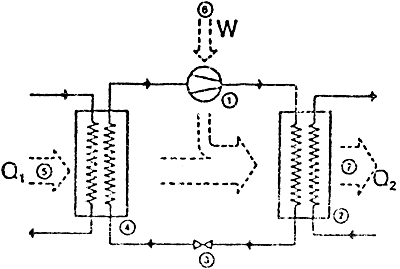 | |
| 1 compressor | |
| 2 condenser | |
| 3 expansion valve | |
| 4 evaporator | |
| 5 heat absorbed al low temperature | |
| 6 compression energy | |
| 7 heat transferred to high temperature | |
Fig. 17 - Heat-pump cycle
The thermal energy transferred in the condenser is represented by:
Q 2 = Q 1 + W
and the Fluid at the end of the cycle contains the same energy.
The work W of the compressor relates to the difference of the pressure P 1 and P 2, and then of the temperature T 1 of the source from where the energy is absorbed and T 2 to where it is transferred.
The performance of a heat pump is usually expressed by a “coefficient of performance” named COP, defined as:

This means the ratio of the useful heat given to the hot fluid (Q 2) and the amount of work (W) necessary to do it.
The practical values of COP range from 2.5 to 4, this means that the calories obtained with the heat-pump are from 2.5 to 4 times greater than those obtainables by an electric heater of the same power.
Fig. 18 represents a shematic plan of an application of the heat-pump

Fig. 18. Schematic representation of a heat-pump utilization
The warm water discharged by a power station can be used both in agriculture and in aquaculture. Studies on the optimization of the use of this water in both these fields have been carried out by several countries, listed in Fig. 19 – 20 – 21.
A study has been conducted to evaluate the dimensioning of a project utilizing in a correct way the entire effluent of a medium size power plant.
Let us consider a power station with 4 units of 320 MWe each, utilizing about 40 m3/sec. of cooled water, located in the centre of ltaly, using the water from the Po river.
Let us utilize half of the oxygen consumption to determine the ratio biomass/water supply, and in supposing that we produce three different species (eel, catfish and carp); for security reasons, only 70% of the effluent of the power station is used.
The project has scheduled fattening tanks; a hatchery with a heat pump system and first rearing tanks; ponds to be utilized as reservoirs and as an additional cooling system for these discharged waters; appropriate facilities.
The total area occupied is 400 ha, 36 of which for intensive fattening tanks, and 360 for ponds. The final production is over 5 500 tons. Fig. 19 – 20.
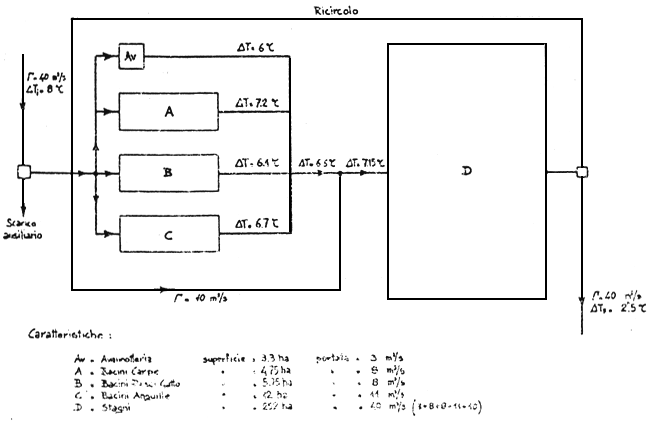
Fig. 19. Energetic balance
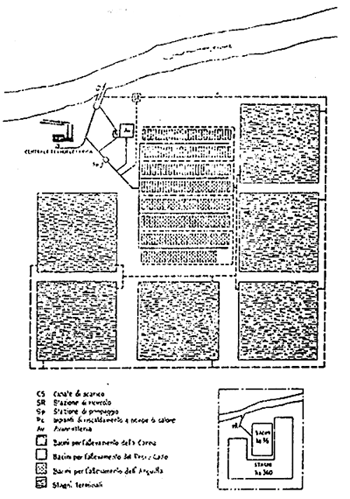
Fig. 20. Ideal thermal fish farm utilizing warm water discharged by a power station
BIBLIOGRAPHY
HOAR, W.S. ; RANDALL, D.J.; BRETT, J.R. 1979.
Fish Physiology. Vol. VIII. Bioenergetics and Growth. Academic Press.
ROGER, G.F.; MATHEW, Y.R., 1965.
Engineering Thermodynamic Work and Heat transfer. Longmans.
WHEATON, F.W., 1977.
Aquaculture Engineering. John Wlley & Sons.
BRONZI, P; PARRINI, F. 1984.
The management optimization of a thermal aquaculture plant. XV annual
ESNA Meeting. September, 3 – 8. PLACENZA.
Mr. G. FANCIULLI
In aquaculture, the production of live food for marine fish larvae, crustaceans and molluscs, is certainly the first important point so as to ensure success.
Indeed, one of the first obstacles encountered during the first attempts of larval rearing was the necessity of having at disposal live food, small in size, in treat quantities and so easily reared.
This was one of the major obstacles for the development of the different techniques of induced reproduction.
In Japan during the sixties, so a relatively recent period, it was remarked by chance that the use of Brachionus plicatilis was interesting as first food for marine fish larvae.
Since then, this direction was followed and the results obtained succeeded in bringing induced reproduction to industrial level. At present, it is now possible to select between two rotifer stocks, small and big, which are distributed in turn.
It has also been possible to regulate the growth of the rotifer by intervening in the food distributed to it.
When the Japanese started using Brachionus plicatilis, the problem of rearing great quantities had to be faced.
The method adopted and later on perfected was to rear Brachionus plicatilis in big tanks. These tanks permitted having very similar conditions to those found in a natural environment, and in eel fattening tanks where the development of rotifers had been remarked.
The method consists in provoking an algal bloom in big cement or plastic tanks on which the rotifer way feed.
Briefly the method is as following:
The tank is filled with sea-water enriched with the traditional nutriments (phosphates, nitrates, and eventually vitamins)
The phytoplankton chosen as food is inoculated (In Japan, Chlorella spp is generally employed).
When the average cellular concentration is reached, the rotifers are inoculated at a density of 15 to 30 ind/ml.
When the useful concentration is reached (150 to 200 ind/ml) a quarter of the culture is token every day or every second day as samples and replaced by sea-water and phytoplankton.
This methodology, is the physiology and ecology of the rotifer is well known, is easily applied and gives good results.
Around 15 years ago, when it was decided to take the first steps towards industrial aquaculture, we tried to imitate the Japanese method. The results were only average and probably due to the fact of the small amount of knowledge acquired in the sector and also perhaps on account of the different ambiant conditions which had been underestimated.
Both France and Italy decided upon the production of live food in smaller tanks under cover. Thus a more sophiscated technology under strict control was adapted in the aim of obtaining greater concentrations of limited space areas.
At first, the big production tanks of algae and rotifers were placed simply under cover, thus vast surface areas were occupied. The surface area occupied by the production of live food covered around 30 % of the rearing structures and so the production casts were greatly increased.
Later on, and as to concern Italy, after 1980, there was an attempt made to decrease the occupied surface area and to increase the productive capacity.
The use of yeast (inovation from Eastern Countries) as food for rotifers provoked a decisive turn in this sector. This has been employed ever since.
Before stating the actual problems encountered and the technologies employed, taken mostly from any own personal experience, I should like to state briefly the different phases around which the production of phytoplankton and rotifers evolve and then to concentrate on mass production in average size volumes.
The algae most employed in aquaculture are, following the description given by PARKER and DIXON, the diatoma: Phacodaectylum tricornutum, Skeletonoma costatum, Cyclotella nana and Chaetoceros calcitrans, which are commonly used in the larval rearing of peneidae.
Haptophycae: Isochrysis galbana, Pavlova lutheri which are both used in the rearing of bivalvular molluscs and since their high content (in comparison to other species) in long chain unsaturated fatty acids has been remarked.
The Prasinophycae: Platimonas suecica, is also used as food for rotifers, together with Chlorophycae : Dunabiella, Chlorella and Nannochloris.
Figure (1) shows the successive culture phases of marine algae, carried out by most aquaculturists. These different transfers, always from smaller to bigger volumes, are carried out so as to reduce the time of culture and to divide up the production cycle into different phases permitting at any moment a more efficient control. The principal motivation behind these divisions is therefore to limit risks for the whole population.
The strain is the most important culture part of the most important culture part of the whole cycle. The medium employed is sterilized sea-water, enriched with nutrients, the normal quantity of which is generally cut by half. The strains are kept at a feeble light intensity and at a temperature of 20 ± 1° C.
The erlenmeyer (Vol of ± 400 ml) is employed as intermediary transit volume in the sole aim of increasing the culture volume.
This volume can be used at any time, and the culture can be kept in it for 4 to 5 months. The volume employed after this is a two liter balloon which is the fundamental unit for the routine replications.
The following diagram shows the work methodology employed from B2 onwards (Figure 2).
When full production is reached, the B2 is the minimum volume in which the work can be carried cut, Diagram shows that in the daily practice of a B2 one can obtain, by simple dillution, a new B2 and, at least, 2 B6 (depending on the concentration, it is possible to vary this relation). The B6 can be either employed to inoculate bigger volumes (bags) or so as to obtain intermediary cultures of rotifers. The use of the pyrexglass balloons will eventually become outdated and will be substituated by the use of the more economic and easily managed PVC bags enriched, with nutrients and then placed in a deep freezer.
When required they are filled with sea-water and inoculated. This practice is at present being present and could permit to speed up the procedure.
Since yeast has been employed, we can consider that the 25 to 30 % bag is the biggest volume employed for unicellular algae cultures. Up to a few years back, the production volumes of phytoplankton were on the contrary tank of several m3. As already stated above, big volumes (more then 50 m3) for the culture of phytoplankton and rotifers are still being used in the Far East. Their great experience in larval and fry rearing, together with the rapid development of this activity carried out on a large scale, allow them to obtain satisfactory results.
The species reared, is the Brachionus plicatilis, universally known and used in all reproduction facilities. The studies carried out on this species, in the aim of improving mass production, have covered many different spheres: The influence of the concentration on the parthenogenetic reproduction, on the temperature and on the quantity and quality of the phyto and salinity rates.
Likewise, the physiological aspects have been studied: the metabolic uniformity concerning the changes in temperature and environment the effects of the salinity and pH rates on the consumption of oxygen and the osmotic regulation.
Finally, while still only imitating the Japanese, the studies have been directed towards the ecological situations which occur in mass cultures.
Also of great importance, are the studies on the biochemical composition of rotifers submitted to different diets. Indeed, it is clear, following the first results obtained, that grave deficiencies can occur in certain compounds necessary for the development of the larva. This is the case for essential fatty acids and especially long chain unsaturated fatty acids (ac. eichosapentaenic, 20 : 5 w 3 and dochosahexaenoic 22 : 6 w 3) which are vital for marine fish and which practically absent in rotifers feeding on yeast or certain algae.
This research brought us therefore to study the principal algal species used in aquaculture so as to emphasize those containing fatty acids.
Like this, we remarked their total absence in Dunaliella and at a lesser degree in Tetraselmis. While it appears that the highest percentage of unsaturated fatty acids is fond in lsochrysis galbana and Pavlova lutheri.
Another sphere of research was developed with the perfectioning of a balanced. inert diet, for rotifers and which could be used as an intermediary therefore in relation to the larva. At present, although a lot of progress has been made in this direction, we can still not define its reliability nor efficiency.
The diagram shows more clearly than any explication could, how the operations, concerning Brachionus plicatilis are carried out (Figure 3). The last tank, where “mass” rearing takes place, can very in size, from 0.5 m3 to 50 m3, depending on the methodology employed. The method described here is that which schedules the use of a tank of up to 1.5 m3.
Before giving details on the mass production the preceding phases shall be briefly recalled.
The strain, like for phytoplankton, is the starting point of every cycle. A test tube and erlenmeyer are employed, in other words volumes from 50 to 500 cc, but it is possible to use only the erlenmeyer, especially during routine periods.
The 6 l balloon is for the intermediary culture which is capable of permitting the “mass” production of rotifers, which in good feeding conditions reach greater concentrations than 300 individuals/ml.
By diluting, we generally obtain 5 bags of 30 l, from a 6 l balloon, having a concentration at the beginning of 10 ind/ml. These bags, containing algal cultures in exponential growth phase, will be ready for use 5 – 7 days after the inoculation, when the rotifers have reached a greater concentration than 200 ind/ml.
With the method hers explained, the bags are used for “mass” production.
If greater dimensions are employed, it is probable that modifications in the rearing method employed will be necessary.
This point will be described in detail. As after many years of work in this sector, I have remarked how difficult it was with neophytes to manage a series of volume, on parallel with the daily need of larvae for rotifers.
Therefore, I should like to try and give the most useful indications permitting efficient management of this sector. Those who rearlarvae, know that this objective will be reached, if it is possible to supply a maximum amount of rotifers, which can be produced daily and this throughout the whole larval rearing period.
The table gives details on the basic abiotic and biological parameters for the management of a big volume:
- filtered and preferably debacterized sea-water (UV lamp treatment)
- temperature : 20 – 24° C
- salinity : around 20 ‰
- aeration : 8 – 10 1/min
- Feeding : a) phytoplankton : 2 – 4 %/day the culture volume in proportion to the concentration of rotifers
b) yeast : till 5 ind/ml - - 4 gr/million
from 50 to 100 2 gr/million
higher than 100 1 gr/million
The shape of the tank for this type of “advanced” rearing will be preferably of cylindro-economical type (like those employed in larval rearing) as they enable excrements and uneaten food to concentrate more easily. It is also useful to schedule a “drain” in the bottom of the tanks so that the accumulated waters can be eliminated daily.
A study carried out over 3 years on the development of the different culture tanks allowed us me to focus, very approximatly, the average parameters where it is most probable to obtain the regular development of a culture.
The graphs (Figure 4) show the development over 3 years of 4 coefficients employed so to estimate the growth of a population, compared with the concentration (per ml) of rotifers when inoculated.
These coefficients are so following:
- R : Intrinsic rates of daily growth
This is a coefficient which express the capacity of a population
to increase exponentially.
- TD : Time necessary for the
population to double in number. Express
the time in days during which a population can double in number.
- NT : Concentration of rotifers per ml when employed.
- GG : average number of days of life in culture
These coefficients have been calculated for a total of 7 cultures during the 1981/82 season ; 148 during 1982/83 and 81 during 83/Feb. 84.
The averages obtained at diverse initial concentrations have been compared by means of Tuskey test which permits to reunite them in the defined groups and to established a value scale (the test is significant) between the differences (if any exist).
These tests have permitted to show that the average value of the 4 coefficients, obtained with an initial concentration of 15 ind/ml is significantly superior to all the others for the 3 seasons.
We can thus affirm with confidence that an initial concentration fluctuating between 10 – 20 ind/ml is that which permits (in following the methodology explained here above) to obtain a value R between 0.36 and 0.39 a time of reduplication varying between 1.8 and 2 days, an average duration of the culture of 7 days and final concentration of between 175 and 215 ind/ml.
The same analysis carried out with tanks of double the capacity volume (1 200 1) didn't give as constant results from one season to another. It may happen that at the dimension aleatory factors could count as remarked with volumes of bigger dimension.
Another parameter studied during this period was the Ro value or fecundity coefficient which is the relation between the total number of eggs counted in a sample and the number of individuals. This value indicates more easily the reproduction capacity of a population. The higher the coefficient, the better the linving conditions of this population will be.
It appears From the results (as seen in the Fig. 5. that the 2nd and 3rd day after the inoculation are those when the population present the greatest amount of eggs and confirms in this way (visibly) the correct development of the population.
Besides these more “matematical” coefficients, there more empiric parameters which permit to control the development of a culture and to schedule its evolution. The use of yeast has permitted by its integration with the algal rythm to obtain higher concentration of rotifers in the cultures. An excessive distribution can cause grave pollution problems which can provoke in a few hours the total destruction of the culture and consequently the difficulties arising from this easily be imagined at larval production level.
The premonitory signs can be the apparition of a more or less thick layer of foam on the surface, rich in proteins and the consequence of an increase of the ammonia level, as well as the persisting typical odour of fermentation.
In this case, the culture water tends to become whitish and not transparent. Therefore, it is better to use the culture immediately, empty the tank and filter the rotifers before they are completely destroyed.
For this reason, in the table presented, I have indicated 3 different doses of yeast, inversely in proportion to the increase of the rotifer concentration.
The data collected over 3 consecutive years of experience show a progressive increase in the results obtained and the methodology employed is confirmed worth while.
ROTIFERS PRODUCTION DURING 4 CULTURE SEASONS
| Years | 1 | 2 | 3 | 4 | 5 | ||||
| 1980–81 | 102.3 | 11.2 | 60.1 | 13.7 | 9 172.1 | 1 506 | 11 | ||
| 1981–82 | 142.5 | 9.9 | 81.3 | 9.1 | 8 494.8 | 764 | 6 | ||
| 1982–83 | 212.7 | 25.7 | 125.0 | 12.5 | 19 445.8 | 1 209 | 9 | ||
| 1983–84 | 205.1 | 75.9 | 123.1 | 45.5 | 10 281.0 | 560 | 9 | ||
| 1981–82 | 102.9 | 9.1 | 128.8 | 0.6 | 3 735.2 | 22.1 | 2 | ||
| 1982–83 | 182.1 | 26.9 | 225.0 | 6.8 | 4 505.0 | 157 | 2 | ||
In column 1, the rotifer concentration per ml concerns the moment of use.
In column 2, the average production for each culture cycle (expressed in millions) and in column 3 the global production for the whole season (expressed in millions). This column must be read while comparing it to column 4 where the total number of days of culture is expressed, in other words, the time during which the tanks were in operation.
The first tests carried out in 1980/81 while employing plat bottom tanks (creating great problems due to the accumulation of wastes) gave the first good results.
During the 81–82 period, we have used conical-cylinder tanks of 600 l, and the techniques employed gave excellent results.
During the 82–83 and 83–84 periods, we have improved on the method employed and so better results were obtained.
With this method, we were able to triple the rpoduction of rotifers when compared to the period when we only used algae as Food, and to reduce the surface area by, at least, 50 %.
As already stated, there exists numerous rearing methods for phyto and zooplankton, each valid, depending on the characteristics of the facilities and of the environment where the work is carried out. One of these methods is that which I tried to explain to you and which is adapted, in my opinion, to facilities located in cold climate regions (possible having right frost and long period during which the temperature is below 10° C) and thus where it is necessary to work under shelter. In this situation, the high cost of construction along with the difficulty (especially in Italy) of obtaining the right for the construction of vast buildings, made us reduce as much as possible the space reserved for rearing. This is why we have insisted on raring live food at very high concentrations.
And so as to obtain this goal, we had to perfect a technique and ensure constant control.
Figure 1: Phytoplankton culture
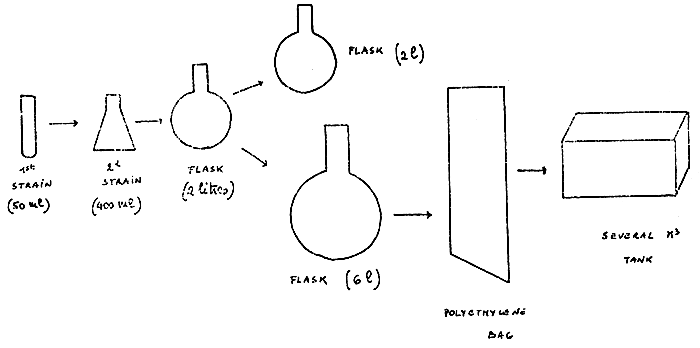
Figure 2 : Routine Cycle of Phytoplankton Culture
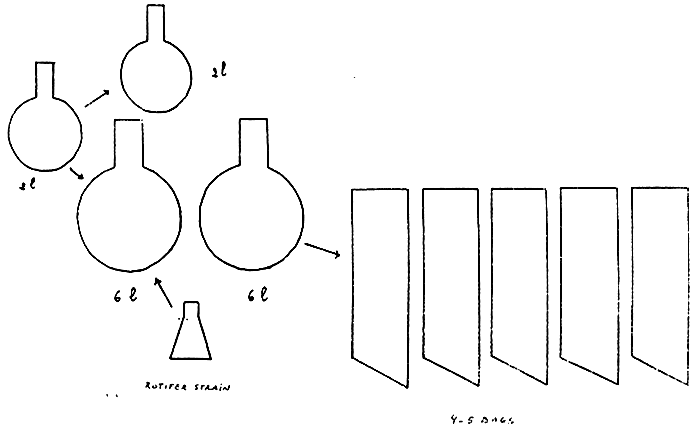
Figure 3 : Rotifer Culture

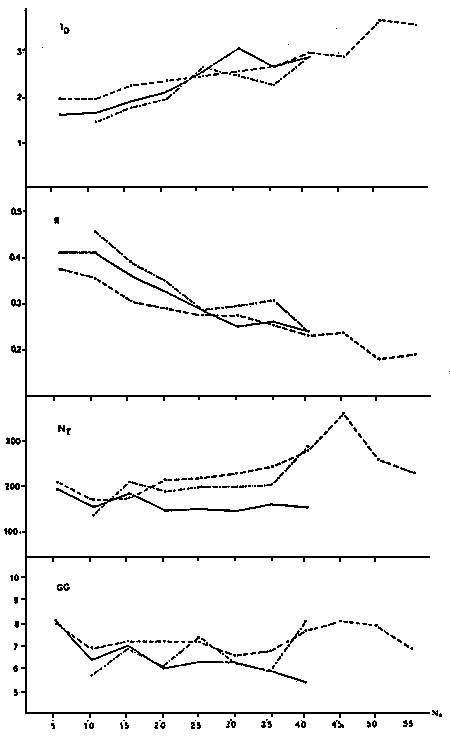
Figure 4 : Evolution of 4 indexes over 3 years, permitting the estimation of growth of a rotifer population.
Figure 5 : Evaluation of the fecundity index Rc
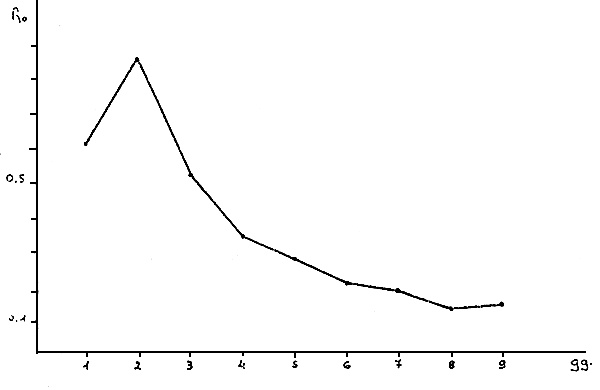
Mr. A. PONTICELLI
The production of phytoplankton and zooplankton to feed marine species larvae remains one of the most important obligations in the management of a modern hatchery.
The production of live food, which in passing, is very expensive, is always obligatory due to the very poor results obtained with inert food up to present.
The failures, with the use of micro-particles are due especially to:
- the absence of movement ; the larvae are attracted towards zooplankton as it is continuously in motion.
- Particles fall to the bottom rather quickly.
- Consequently the tank becomes polluted more quickly.
To these points, let us not forget to add, that, for the culture of certain species, in particular molluscs and crustaceans, phytoplankton plays a very important purifying and bacteriostatic role. It appears thus that for the future primary and secondary productions shall be irreplaceable in a hatchery productive system.
Intensive production systems of zooplankton have reached an excellent level of reliability.
TROTTA (1980 a ; 1980 d ; 1983) has recently described an intensive production module of 100 million rotifers per day. This production level can largely satisfy the requirements of an average size hatchery.
The intensive production method employed for zooplankton although surely valid after verification and due to the results obtained, has also some disadvantages especially from an economic viewpoint.
- Very high investment costs.
- Management costs ; energetic, personnel.
Intensive production due to the aseptic requirements, needs in particular the intervention of specialized personnel.
The investment and management costs of an intensive phytoplankton and zooplankton production unit is really only suitable for large aquaculture facilities
The intensive production method remains unequalled today but it could be seconded by other systems of extensive production, in other words in large volumes.
The production of zooplankton (especially rotifers) following this method, schedules the employment of very large culture volumes (10 – 80 cubic meters or more).
The fundamental differences between the culture of zooplankton carried out in large volumes and intensive culture are as following:
- A non monoxenous condition : several species of zooplankton and phytoplankton are present in the culture at the at the same time.
- The density of the plankton in rearing is lower (15 – 70 rotifer/ml on average).
Let us take as example a tank of 70 cubic meters equipped with an aeration system. The tank will be supplied with sea-water and if possible fresh water will be added (Optimum salinity 25 ‰).
The water is fertilized with agricultural manure according to the formulas shown in Table 1: the tank should be cleaned out first (IPPM bleach) so as to eliminate any undesirable organisms.
The phytoplankton is inoculated in the tank, normally Chlorella sp is employed (3 – 4 cubic meters of culture at a density of 5 – 10 million cells per ml) ; After a few days depending on the season and the light intensity, the phytoplankton reach a concentration of 10 – 15 million celles per ml; at this moment. rotifers from other cultures are inoculated at the initial concentration of 4 – 10 ind/ml.
The rotifer concentration increases rather quickly; when it reaches 15 – 30 and/ml (the colour or the culture changes very quickly from green to brown) yeast is given (up to a maximum of 500 gr par day for a 70 cubic meter tank). After a few days of rearing if an important presence of protozoa is remarked, bleach is employed in the culture medium itself, at a rate of 0.3 – 0.5 ppm. This operation permits the elimination of protozoa without any dangerous effects being caused to the culture.
With this type of culture, we have reached concentrations of 30 – 60 rotifers/ml with a maximum of 114/ml in Summer which corresponds to a production of 4 billion rotifer (PONTICELLI et al., 1985).
At these concentrations, the culture will normally degenerate very quickly There the technicians in charge should keep the concentrations below 50 – 60 ind/ml by frequently collecting them every now and then.
This type of culture is mostly carried out for the present in Japan, in the larges production centres of juveniles, employed for restocking.
A typical production unit for zooplankton will consist in 8 tanks, equipped with an aeration system of 150 cubic meters.
After fertilization we must wait for the phytoplankton to reach a concentration of 5 – 10 million cells/ml. At this moment rotifers are introduced at a rate of 100 ind/ml. On the second day of culture, fish liver oil enriched yeast is distributed at a rate of 500 – 2 000 g/day per tank.
In these types of cultures, the rotifer concentrations can reach 400 ind/ml, but in a much shorter duration, two weeks at the most (more frequently not more than 6 – 7 days is required).
Thus every day in the tank 2.3 billion rotifers can be filtered over several days.
At TAKEHARA stocking centre in Japan, 1,221.8 billion rotifers were harvested for the production of 4 million madal (red sea bream) in the period from April to July (HENOCQUE, 1984 - Fig. 1).
This method is thus based on the regular change and renewal of the cultures (every 6 – 10 days).
However, the quantities of water, fertilizers and food required bring about high costs.
For hatcheries located near brackish water lagoons, there exists another possibility, through the zooplankton yield found in the bordering zones of the lagoons, places where there exists very feeble renewals and eutrophic water.
A second possibility consists in the correct culture of zooplankton in fertilized earth tanks (GEIGER, 1983; DOYLE et al., 1984).
These techniques were applied mostly in the South of France in the Languedoc_Roussillon region which has numerous wet zones, brackish water lagoons and salt marches (BARNABE. 1978, 1980, 1984).
While taking into account that the zooplankton concentration is rather feeble, the most important problem to resolve is the perfecting of an automatic harvesting device; this harvest must be carried out quickly while not interfering with the plankton.
An automatic harvesting device for zooplankton (BARNABE, 1980 ; PONTICELLI et al., 1985) consists in a PVC cylinder, 30 cm in diameter, 50 cm in length, in the centre of which a propellor rotates by means of a 50 watt powered motor and a set of gear wheels (see fig. 2). MORETTI. 1985).
The cylinder is maintained in a horizontal position below the water level by means of floats of appropriate volume.
The propellor, in rotating inside the cylinder, provokes a constant water flow which is filtered through a 4 meter long net which retains the zooplankton. A plankton net of different mesh spacings is used depending on the size of the organism we want to fish (The mesh spacings vary between 50 μm and 500μm). The power drive is ensured by a 60 ampere-hour accumulator, connected to the motor by means of a 2 millimeter section cable.
An electronic regulator of very feeble electric consumption, permits to vary the rotation speed of the propellor between 80 and 250 rotations per minute.
This causes a water flow supply in the cylinder of between 70 and 400 liters per minute.
The rotation speed is chosen in accordance to the zooplankton concentration; normally a feebler rotation speed is employed when there are very important zooplankton concentrations or when the water contains a lot of organic matter in suspension (The clogging up of the net can cause it to tear with a strong water flow and thus the loss of the plankton is inevitable).
The collector is also equipped with a feeble power lamp (2 W) which, when night fishing is carried out, attracts the zooplankton, and in this way, the yield efficiency is imporved.
The most abundant zoological groups are rotifers, copepods, ostracods and in oversalted water tanks, Artemia.
The most interesting salinity rates for the production of zooplankton are those varying between 10 and 20 ‰.
The oxidation pond method is employed to purify polluted water coming from small communities by means of large ponds: When the treatment is completed the effluent possesses chemical and bacteriological characteristics quite similar to those of water for bathing.
The oxidation ponds are quite large (1 ha around to purify waste water from villages of 1,000 inhabitants). Normally, the oxidation pond method is carried out with the use of three ponds known as stabilization ponds where the water flows through one after the other. In the first pond, there is a very important bacterial activity, in the second one a phytoplankton one and in the third a zooplankton activity.
The three ponds are shallow (1 m to 1.5 m so as to allow the complete oxygenation of the whole water body and the penetration of light. The ponds are in an “S” shape which helps in obtaining a maximum hydrodynamic effect in the oxidation pond.
The zooplankton is represented essentially by groups of animals. Ciliates which consume bacteria, rotifer which consume phytoplankton and bacteria reaching concentration of 150 ind/ml, copepods (crustaceans of 200 – 500 μm) which mostly consume phytoplankton and finally daphnids (large crustaceans of 1 to 3 mm).
Daphnids can reach a density of some hundreds of ind. per litre.
The production from an oxidation pond is enormous, 40 – 60 ton/ha/year of phytoplankton and 8 – 9 ton/ha/year of zooplankton (in a fresh biomass).
Zooplankton can be collected from the oxidation pond:
- passively, by adapting a filter chute onto the outlet mozzle of the effluents,
- by means of collectors similar to those already described here above,
- by means of strainer-collectors; in this case, the water is pumped, and let flow over a series of rotating cylinder strainers of smaller and smaller space meshings.
When the zooplankton has been collected, it can be directly employed to feed marine species fry, such as sea-bass. BARNABE obtained good survival rates of sea-bass fry which were fed solely live zooplankton from day 40 to 100. Zooplankton may also be dried or frozen.
The ORBETELLO municipal hatchery (Italy) has carried out for several years zooplankton production techniques while employing larger volumes (SALVATORI et al., 1985).
Five tanks of 70 cubic meter are used in the hatchery, for the culture of rotifers and copepods. Larval rearing takes place in 6 tanks of 18 cubic meters which have an open circuit system. Indeed, a sea-water well will water 15 liters per second of water with a constant temperature range of 25° C. The water from the well is mixed with the cold sea water so as to obtain a temperature of 12 – 15° C for rearing.
Rotifers (produced according to the technique described in paragraph 3.1. in tanks of 70 m3) are collected either manually by means of an automatic collector or more frequently by means of a simpler collector equipped with an air-lift (ANGELINI, pers, Comm. ; See fig. 3)
To increase the temperature to the rotifer culture tank a simple PVC pipe exchanger was tested and gave good results.
The water from the well at 25° C, circulating through the pipe (tens of meters in length), heats the zooplankton culture water, and permits an increase in temperature of 3 – 4 degrees.
Two outside basins of 600 and 250 m2 are also employed for the extensive production of zooplankton (rotifers, copepods, ostracods).
The basins are fertilized by means of organic or inorganic agricultural manure.
The zooplankton is collected by means of an automatic collector. The collector for the 600 m2 basin is installated near the foot bridge and can be operated automatically at the time desired by the technicians. Indeed, a time clock can be set to start off the collector during the night or in the early morning. On arrival at the hatchery, the technicians will find a collection of several hours ready for distribution to the larval rearing tanks.
From time to time harvests are also carried out in places located far from the hatchery; for example in a part of a lagoon of 40 ha, which is very shallow and eutrophic or in low lying lands located below lagoon level and submerged during winter by 30 – 40 cm of water which from time to time contains an abundancy of zooplankton.
In another aquaculture facility located in Southern Italy (ITTICA Ugento - LECCE) the intensive zooplankton production in the hatchery is seconded by a outside production in large volumes.
Indeed, following the sale of the eels, sea-bream in the month of December some of the concrete tanks remain empty until the month of April. This period corresponds exactly to the period maximum need of zooplankton so as to feed sea-bass and sea-bream larvae.
The concrete tanks of 1,200 m3 are therefore fertilized according to the formula which has been already stated here above and the zooplankton is collected by means of an automatic collecting device.
The production of zooplankton which is the key to the productive process of a hatchery remains one of the chief obstacles for the development of marine aquaculture.
Intensive rearing of zooplankton on micro-algae monoxenic cultures, although verified and successful, requires very high investment and management costs.
It also requires specialized personnel which small and average size enterprises do not always have at disposal.
The production of zooplankton in large volumes where the collection is carried out by automatic systems, in very eutrophic lagoonal mediums, is an excellent opportunity for many which have large surface areas at disposal or are located in the proximity of a brackish water lagoon.
We may consider a situation as optimal when an intensive zooplankton production at hatchery level, is seconded by a production carried out in large volumes or by means of automatic collection in extensive basins.
| Fertilizers | Quantity (g) | ||
| 1 | 2 | 3 | |
| Ammonium sulphate | 100 | 100 | - |
| Calcium oxide superphosphate | 20 | 20 | 15 |
| Clewat 32* | 4 | 4 | 5 |
| Urea | - | 4 | 50 |
| Clewat-32 | (en %) | |||
| FeCL3 | .6H2O | 0,385 | CuSO4 5H2 O | 0,007 |
| ZnCl2 | 0,166 | (NH4)6 Mo7 O24 4H2O | 0,632 | |
| MnCl2 | .4H2O | 0,776 | H3BO3 | 2,470 |
| CoCl2 | .6H2O | 0,017 | (HOOCCH2)2 NCH2 N(CH2COOH)* | |
* EDTA (Ethylene-diamine-tetraacetic acid)
TABLEAU 1 - Fertilizers employed according to there different formulas
and Clewat 32 composition. Quantities indicated for 1 m3
of water .
(HENOCQUE, 1984)
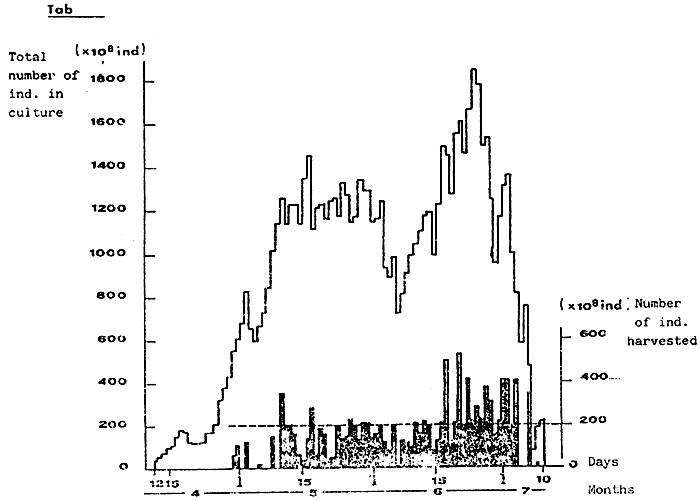
Fig. 1 - Rotifer culture from April to July 1982 at the Takehara Center, in Japan. (HENOCQUE, 1984)
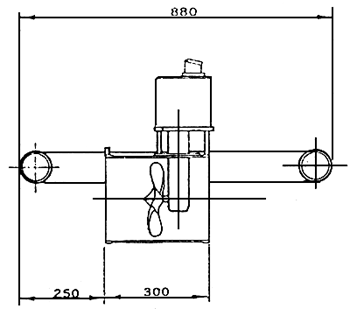 | 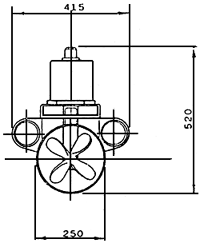 | |
 | Weight | Kg.13 |
| Voltage | 12 v | |
| Motor drive | 50 w | |
| Min. speed | 80 RPM | |
| Max. speed | 250 RPM | |
| Max. flow | 400 lt/l. | |
| Min. flow | 70 lt/l. | |
| Min. absorbtion | 2 A | |
| Max. absorbtion | 3,2 A | |
Fig. 2 - Automatic collector for zooplankton
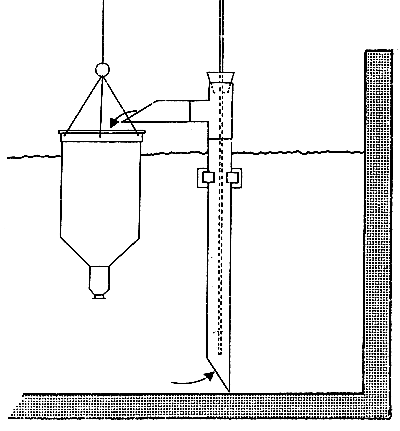
Fig. 3 - Rotifer collector operating with an air-lift
(M. ANGELINI)
BIBLIOGRAPHY
BARNABE G., 1978. Utilisation des chaînes alimentaires naturelles et du recyclage des eaux usées dans la production à grande échelle de juvéniles pour l'aquaculture. Publ. Sci-Tech. CNEXO; Actes colloq., 7: 221 – 238.
BARNABE G., 1980 - Système de collecte du zooplancton à l'aide de dispositifs autonomes et stationnaires. In R. Billard, La Pisciculture en Etang. I.N.R.A. Publ. PARIS : 215 – 220.
BARNABE G., 1984 - Utilisation de plancton collecté pour l'élevage de poissons marins. In BARNABE G, et BILLARD R. Ed., L'aquaculture du Bar et des sparidés, I.N.R.A Publ., PARIS, 185 – 207.
DOYLE K., BOYD C., 1984 - The timing of inorganic fertilisation of sunfish ponds. Aquaculture, 37 : 169 – 177.
GEIGER J.G., 1983 - A review of pond zooplankton production and fertilization for the culture of larval and fingerling striped bass. Aquaculture, 35 : 353 – 369.
HENOCQUE Y., 1984 - Production de nourriture à grande échelle en écloserie. Rapport de mission. Maison Franco-Japonaise. 8 pp.
MORETTI A., 1985 - Utilizzo di zooplacton nei processi produttivi in acquacoltura. Rapp. Fin. di Attività. Contratto ENEA № 25073. 25 pp.
PONTICELLI A., ANGELINI M., LENZI M., SALVATORI R., 1985 - Raccolte di zooplancton in ambienti eutrofici a mezzo di un'apparecchiatura automatica. XVI Convegno S.I.B.M. - LECCE 25–30 Settembre 1984. Oebalia Vol XI. N.S. 181 – 186.
SALVATORI R., ANGELINI M., LENZI M., FOMMEI F., PONTICELLI A., 1965. Allevamenti larvali di Dicentrarchus labrax mediante utilizzazione di acque ipotermali. Tre anni di esperienze. XVI Congresso S.I.B.M., LECCE. 25 – 30 Settembre 1984. Oebalia Vol. XI - 2 N.S. : 729 – 736.
TROTTA P., 1980 a -A simple and inexpensive system for continuous monoxenic culture of Brachionus plicatilis Muller as a basis for mass production. In algae Biomass ; eds Shelef, C.J. Soender and M. Balaban, Elsevier/North Holland Biomedical press, AMSTERDAM.
TROTTA P., 1980 b - A simple and inexpensive system for continuous monoxenic mass culture of marine microalgae. Aquaculture, 22 : 383 – 7.
TROTTA P., 1983 - An indoor solution for Mass Production of the marine microalgae Tetraselmis suecica Butcher. Aquacultural Engineering, 2 : 93 – 100.
Mr. P. SORGELOOS, P. LEGER, P. LAVENS and W. TACKAERT
Modern aquaculture production is achieved through complete domestication of cultured species, e.g. fishes and crustaceans. This involves the elaboration of “egg to egg” culture techniques contrary to earlier farming of wild caughtfry. Mother animals are induced to spawn in captivity. Their offspring are transferred to culture tanks where the larvae grow onto a juvenile or postlarval stage. In the following “nursery” phase, juveniles are conditioned for the transfer to natural conditions in the “grow-out” ponds or cages where they are farmed up to a marketable size on natural plankton and/or benthos eventually supplemented with prepared feeds. A small part of the harvest is used to restock the “maturation” unit, closing the cycle.
Intensive larvae-production of most marine fishes and crustaceans is still hampered by the requirement for live food, at least during their early stages. Since the techniques for collecting or culturing their natural diet, characterized by a wide diversity of plankton, are either commercially unfeasible or technically hard to realize, a suitable substitute for natural plankton had to be found. The most used live food in the successful larval rearing of fishes and crustaceans is the brine shrimp Artemia. Technically speaking, the advantage of using Artemia is that one can produce live food “on demand” from a dry and storable powder, i.e. dormant Artemia cysts (eggs) which upon immersion in sea-water regain their metabolic activity and within 24 hours release 0.4 mm free-swimming larvae (nauplii). Actually more than 100 tons of dry Artemia cysts are marketed annually for worldwide production of freshly hatched Artemia nauplii to be used as food in the hatchery phase of fish and crustacean aquaculture.
The history of Artemia cyst production and use reveals an interesting evolution. In the 1960's commercial provisions originated from a few sources in North America which seemed to be unlimited. However, with the expansion of aquaculture production in the 1970's, the demand for artemia cysts soon exceeded the offer and prices increased exponentially. The dramatic impact of the aggravating cyst shortage on the expansion of hatchery aquaculture of marine fishes and crustaceans was repeatedly underlined at international conferences. Especially the third world countries could hardly afford to import the very expensive cysts.
Fundamental and applied research with brine shrimp Artemia was initiated at the Ghent State University in the early 70's. Based on our (theoretical) knowledge we claimed at the KYOTO 1976 FAO Technical Conference on Aquaculture that the cyst shortage was an artificial and only temporal problem. During the following years, several national and international aid organisations provided opportunities to verify our theoretical claims and to prove the possibility of the local production of cheap Artemia in various third world countries. As of today Artemia is being produced and exploited on the five continents. In addition, demonstrations of integrated Artemia production have been|are being set up in several third world countries opening interesting opportunities for improved socio-economic situations.
Brine shrimp Artemia have unique characteristics which offer a great potential for mass production purposes :
- In optimal conditions brine shrimp grows from larva to adult in less than two weeks increasing in length by a factor 20, and in biomass by a factor 500;
- Abiotic as well as biotic requirements do not change throughout the animal's development;
- Artemia can be cultured in a wide range of water salinities ; i.e. from 10 ppt to saturation level. Above 100 ppt, no predators nor food competitors survive resulting in a monoculture under natural conditions;
- Several hundreds of natural strains of Artemia are found in coastal salinas as well as inland salt lakes (rich in chlorine, sulphate or carbonate salts) found on the five continents;
- This crustacean can reproduce in two ways, either live reproduction (free-swimming nauplii) or cyst production (the embryos develop into gastrulae at which stage the are encapsulated in a cyst shell and their metabolism is reversibly interrupted.
- Artemia has a high fecundity rate (more than 100 cysts or nauplii, every four days) and a long lifespan (exceeding six months);
- Since this animal is a non-selective particulate filter-feeder, a wide range of very cheap foodstuffs and fertilizers can be considered to culture Artemia, e. g. organic manures (chicken dung), agricultural byproducts (rice bran, whey, brewer's yeast), etc… ;
- Artemia can be successfully grown in very high densities (i.e. more than 10,000 animals per liter) in salt water, and is not very demanding as to the qualitative and quantitative composition of this water;
- The adult brine shrimp has a very high nutritional value : i. e. its exoskeleton is very thin (less than 1 um), 60 % of its dry weight consists of proteins, rich in essential amino-acids ; Artemia furthermore contain significant concentrations of vitamines, hormones, carotenoids, etc…
Proper knowledge of the biological and ecological (life cycle and habitat) characteristics of brine shrimp reveal the potential to exploit existing natural sources of cysts and biomass in operational saltworks (salinas) or salt lakes. The natural distribution (better “dispersion”) of Artemia can be enhanced by human intervention, i.e. introduction (better “transplantation”) of a selected Artemia strain into a suitable environment (e.g. operational salina) can result in the establishment of new Artemia populations which eventually can be commercially exploited. In regions with a pronounced rainy season Artemia cannot resist predation during the wet season and should be re-inoculated at the onset of the dry season when the salinity conditions can support a monoculture of brine shrimp. Small ponds, manured with chicken dung can yield up to 20 kg dry weight cysts or 1,500 kg live weight adult Artemia (so-called “biomass”) per hectare and per month. Although already at commercial operation in artisanal saltworks in S.E. Asia, this type of Artemia production can be further optimized and requires more extension services. In view of the beneficial effects of Artemia on solar salt production, integrated production of salt and brine shrimp, eventually combined with shrimp farming provide the most attractive cost-benefits. Furthermore, this possibility to valorize abandonned salinas or to revitalize solar salt production systems operated at the limits of profitability (many examples in several third world countries in Asia and America) opens interesting opportunities for socio-economic improvements in depressed areas.
When conditions for pond production of Artemia are inappropriate (e. g. too low salinity levels during the rainy season) intensive culture techniques with natural seawater and micronized agricultural byproducts such as rice bran can be set up within the fish or shrimp farm. Using batch or flow-through culture systems, bi-weekly yields of 5 respectively 25 kg live weight Artemia can be obtained per tank of 1 m3 content. The production cost of Artemia biomass grown in intensive culture systems is much higher than from wild harvests or pond produced biomass. Nevertheless, this new type of controlled Artemia production can easily be integrated in the hatchery operations (similar technical prerequisites), be operated on a year round basis, and moreover providing better opportunities for quality control/manipulation (size, biochemical composition) of the Artemia as a nursery and maturation diet (see further).
Improved technologies of cyst/biomass harvesting and processing (cleaning, freezing|drying and packaging) should be applied as they influence the quality of the endproduct.
In many situations, the utilization of Artemia in fish and shrimp farming can be greatly improved. Although the production of nauplii from hatched cysts appears to be a simple procedure, simple precautions have to be taken to ensure maximal hatching outputs when incubating large quantities of cysts (e.g. optimal conditions for temperature salinity, oxygen, pH, light and disinfection). For several reasons, the use of “decapsulated” Artemia cysts are to be preferred in the fish/shrimp hatcheries. Through oxidation with hypochlorite, the outer shell of the cysts can be removed without affecting the viability of the embryo. Upon incubation in seawater, the hatching output of these disinfected and naked embryos has increased and their nauplii have a higher energetic values as compared to the nauplii produced from untreated cysts ; the use of decapsulated cysts furthermore eliminates the needs of the cumbersome separation of the nauplii from the empty shells.
Since the commercial availability of various Artemia originates from widely different geographical sources, significant differences in larval culture success have been reported with several fish and shrimp species. The Artemia nauplius size can be too large for handling and ingestion by the larves. It is therefor advisable to start feeding with frequent additions of freshly hatched nauplii from selected Artemia strains producing small nauplii. So to reduce hatching operations and to ensure maximal valorisation of the nauplii, high Artemia concentrations can be stored at low temperature for up to 48 hours.
Detailed biological and biochemical analyses revealed that the nutritional composition of particular Artemia strains or even of specific batches from the same strain does not always meet the requirements of the fish or shrimp larvae. Probably, the most critical factor determining the dietary value of Artemia as a food source for marine fish and shrimp larvae is the presence and concentration of HUFA's (Highly unsaturated fatty acids 20 : 5 w 3 and 22 : 6 w 3) which, in function of the strain or even the specific batch of cysts from the same geographical origin might be inconsistent to minimal if present at all. In order to overcome this variation in biological effectiveness of specific Artemia cyst products, enriched diets have been formulated and bioencapsulation techniques developed. Application of these new techniques result in significant improvements of the nutritional effectiveness of the latter low quality cyst products ; i. e. diets containing HUFA-levels are bioencapsulated in the gut of the Artemia nauplius during its hatching incubation or after separation of the emerged nauplii. Using this Artemia bioencapsulation technique, it has been demonstrated that hatchery production yields can be increased considerably (i. e. higher survival, larger/bigger larvae, better disease resistance, fewer difformities, better pigmentation, etc… ).
Because of limited availability, the use of ongrown and adult Artemia has mostly been restricted to relatively small scale culture trials. During recent years, however, commercial scale use of Artemia biomass harvested from local saltworks (especially in S.E. Asian countries, but also Brazil, Panama and Ecuador) is gaining more and more interest especially at nursery stage (in both fish and shrimp farming) and for the maturation of penaeid shrimp. Feeding adult Artemia for one to two weeks to the juveniles in nursery ponds or intensive raceways results in significant increases in nursery survival and growth. A diet of adult brine shrimp not only is optimal for hatchery reared fry at its transition from a controlled environment to fluctuating conditions in the wild, it has also proven to be very useful for acclimating wild fry (e.g. milkfish) that often have become weak as a result of excessive handling and transport.
In addition, it has recently been found that a diet of Artemia-biomass can improve maturation success in several Penaeus shrimp species. Further enhancement of the nutritive properties of the Artemia biomass can be achieved by application of the bioencapsulation technique with enriched products (e.g. emulsified diets for enhancement maturation, better postlarval pigmentation, vitamin supplementation, prophylactic treatment, etc…
The above stated developments of Artemia enriched diets have been at the origin of the development of algal substitutes which are successfully applied for feeding the first stages of penaeid shrimp (Zoe and Mysis). Unicellular algae production (e. g. Skeletonema, Tetraselmis, Chaetoceros) not only is very costly (investment, energy, products and labour), it has also been proven on several occasions that their nutritional effectiveness may vary considerably throughout the year. In this regard, the availability of an inert substitute, as an “off the shelf” feed, that will guarantee a constant and equal performance in the hatchery outputs may be considered as major breakthrough in shrimp farming.
ACKNOWLEDGEMENTS
Research at the Artemia Reference Center is sponsored through the Belgian National Science Foundation (Grant FKFO 32.0012.81) of which P. SORGELOOS is a senior scientist : the Belgian Administration for Development Cooperation (ABOS); the institute for the Promotion of Industry and Agriculture (IWONL) and the NU Artemia Systems.
LITERATURE OF INTEREST
LAVENS P., LEGER Ph., SORGELOOSP., 1986 - Production, utilization and manipulation of Artemia as food source for shrimp and fish larvae. Oceanis, 12 (4): 229 – 247.
LEGER Ph., SORGELOOS P., 1985 - Nutritional engineering improves outputs of brine shrimp Artemia. Aquaculture magazine, 11 (5) : 24 – 30
LEGER Ph., BENGTSON D.A., SIMPSON K.L., SORGELOOS P., 1985 - The use and nutritional value of Artemia as a food source. Oceanogr. Mar. Biol. ANN. Rev., 24 : 521 – 623.
SORGELOOS P., LAVENS P., LEGER Ph., TACKAERT W., UERSICHELE D., 1986 - Manual for the culture and use of brine shrimp Artemia in Aquaculture. Artemia Reference Center, State University of GHENT, BELGIUM, 319 pp.
SORGELOOS P., BOSSUYT E., LAVENS P., LEGER Ph., VANHAECKE P., VERSICHELE D., 1983 - The use of the brine shrimp Artemia in crustacean hatcheries and nurseries : 71 – 96, In : CRC Handbook of mariculture. Vol I. Crustacean Aquaculture. McVey J. P. (Ed.) CRC Press, Inc., Boca Raton, Florida, USA, 442 pp.
PERSOONE G., SORGELOOS P., ROELS O., JASPERS E., (Eds) 1980 - The brine shrimp Artemia, volume 3. Ecology, Culturing, Use in Aquaculture. Universa Press, WETTEREN, Belgium, 456 pp.
VERSICHELE D., LEGER Ph., LAVENS P., SORGELOOS P., 1986 - L'utilisation d'Artemia. In : Aquaculture. Vol. I. Brunabé G. (Ed.) Technique et Documentation, Lavoisier, PARIS, France, 521 pp.
Mr. V. FRANCEVIC, D. LISAC, J. BUBLE, Ph. LEGER, P. SORGELOOS
1. INTRODUCTION
The quality of Artemia nauplii plays a very important role in the nutrition of marine fish larvae. Very often often mass mortality or fish lethargy have been reported when feeding low quality livefood (reviews in WATANABE, 1983, and LEGER et al., 1986). It was observed that nutritional quality of Artemia for marine fish larvae is mainly determined by the content of essential fatty acids, i.e. the highly unsaturated fatty acids 20 : 5 w 3 and 22 : 6 w 3, Experiments at laboratory scale with larval sea-bass, Dicentrarchus labrax, fed with enriched Artemia nauplii (ROBIN et al., 1981, VAN BALLAER et al., 1985) pointed out the importance of this problem.
The purpose of this experiment was to define the influence of Artemia nauplil quality from the standpoint of HUFA) on the larval production figures in mass intensive rearing of Dicentrarchus labrax.
2. MATERIALS AND METHODS
25 larval rearing tanks of 2 m were stocked with 40 000 larvae and fed the same quality rotifers (Brachionus pl;) for nine days. Culture water (38 ppt S, 19–20° C) was exchanged at a rate of 30 % par hour. A natural photoperiod was applied not using artificial light. After nine days five treatments (five replicates each) were started using different qualities of Artemia nauplii from the standpoint of w 3- highly unsaturated fatty acids (See table I and II). Techniques used for the mass production of Artemia nauplii from decapsulated cysts have been described in FRANICEVIC (1987). Artemia enrichment was performed using an emulsified diet (SELCO, Artemia Systems, NV, GHENT, Belgium) rich in HUFA. Enrichment was done in the hatching medium according to the procedure described by LEGER et al., (1987a).
The fatty acid profile of freshly hatched nauplii, and enriched nauplii was determined according to the method described by LEGER et al., (1985 b). Wet weight, length and survival of the fish larvae have been determined after 9, 23 and 42 days.
3. RESULTS AND DISCUSSION
Data for survival, mean length, mean weight and calculated biomass production (= product of number of surviving larvae and mean individual weight) are summarized in Table III. HUFA-factors were calculated for 20 : 5 w 3 and 22 : 6 w 3 by multiplying the mg/g values of these HUFA's in Artemia with the number of days these Artemia were fed to be larvae.
The data in Table III indicate that growth is similar in all treatments until day 23. At the end of the experiment, however, clear differences in both mean length and weight are apparent. Those treatments which received w 3 HUFA enriched Artemia nauplii (treatment 3 and 5) gave best results.
When relating calculated HUFA factors to growth data after 23 days Artemia feeding it appears that w 3 HUFA in Artemia do not play an important role for larval growth. A different picture. however, is seen after 42 days of culture, i.e. 22 : 6 w 3 content in Artemia and larval growth are clearly correlated. The level of 20 : 4 w 3 in Artemia does not seem to play a determining role for growth (e.g. treatment 1 VS T).
Except for treatment 2 receiving freshly hatched Great Salt Lake Artemia nauplii, differences in survival are not as pronounced. Mortality in treatment 2 was complete by day 35. This confirms earlier observations by VAN BALLAER et al., (1985) who suspected a possible interaction from pesticide contamination in this Artemia source. Since we found satisfactory survival and growth in the larvae fed w 3 HUFA enriched Great Sale Lake Artemia, we would rather minimize the interaction of contamination, and stress the deleterious effect of the w 3 HUFA deficiency in this diet. A similar relation has been reported earlier by WATANABE et al., (1982) for larvae of the red sea bream Pagus major.
Contrary to larval growth. survival indeed seems to be affected by the 20 : 5 w 3 content in Artemia e.g. increasing survival with increasing 20 : 5 w 3 factor). For this larval biomass production in Dicentrarchcus labrax is directly related to the content of both 20 : 5 w 3 and 22 : 6 w 3 in Artemia.
Our results have indeed proven that supplementation of essential fatty acids through Artemia enrichment can significantly improve larval production success in commercial intensive sea-bass farming. In view of the varying concentrations of 20 : 5 w 3 among strains and even between lots of the same Artemia strain, and since the other essential fatty acid 22 : 6 w 3 is generally lacking in freshly hatched Artemia (LEGER et al., 1986) HUFA enrichment is recommended as a routine practice in larval sea-bass culture.
4. ACKNOWLEDGEMENTS
The authors wish to thank the staff of CENMAR and the Artemia Reference Center for their technical assistance which enabled the experiments and the analysises to be carried out.
Table I : FOOD REGIMES
| Treatment | Food Regime |
| 1 | AF 858/24 (Artemia Systems N.V., GHENT, Belgium) freshly hatched Artemia nauplii throughout (42 d) |
| 2 | GSL (Great Salt Lake, Utah, USA) Freshly hatched Artemia nauplii throughout |
| 3 | GSL freshly hatched Artemia nauplii during ten days + GSL/S (Great Salt Lake. 24 h enriched with Selco, Artemia Systems N.V.) Artemia nauplii up to the end of the experiment |
| 4 | SFB (San Francisco Bay, San Francisco Bay Brand, CA-USA) freshly hatched Artemia nauplii throughout |
| 5 | AF 858/24 freshly hatched Artemia nauplii during ten days + GSL/S Artemia nauplii up to the end of the experiment. |
Table II
W 3 HUFA content (expressed as area percent of total fatty acids and mg per gram dry weight Artemia) in freshly hatched and enriched Artemia nauplii.
| Artemia | ||||||||
| AF 858/24 | GSL | SFB | GSL/S | |||||
| Area % | mg/g | Area % | mg/g | Area % | mg/g | Area % | mg/g | |
| 20 : 5 w 3 | 5.3 | 7.7 | 0.3 | 0.4 | 1.9 | 2.3 | 4.9 | 8.1 |
| 22 : 6 w 3 | - | - | - | - | - | - | 3.1 | 5.1 |
Table III
Data on mean individual length, wet weight, survival and calculated biomass of D. labrax larvae fed different quality of Artemia nauplii (See Table I) ; also given are w 3 HUFA factors, calculated as the sum of products of mg/g HUFA 20 : 5 w 3 or 22 : 6 w 3 in Artemia and the number of days these Artemia were fed.
| Treatment | ||||||
| 1 | 2 | 3 | 4 | 5 | ||
| Length (mm) 23 d | 6.99 | 7.46 | 7.74 | 7.35 | 6.82 | |
| 42 d | 14.38 | - | 17.25 | 14.51 | 16.48 | |
| Wet weight (mg) 42 d | 14.01 | - | 24.45 | 14.27 | 24.60 | |
| Survival (%) 42 d | 22.54 | 0 | 20.00 | 18.18 | 24.36 | |
| Calculated biomass (g) 42 d | 126.3 | - | 195.6 | 103.8 | 239.7 | |
| HUFA factor d 23 for 20 : 5 w 3 | 177.1 | 9.2 | 109.3 | 52.9 | 182.3 | |
| HUFA factor d 23 for 22 : 6 w 3 | - | - | 66.3 | - | 66.3 | |
| HUFA factor d 42 for 20 : 5 w 3 | 323.4 | 16.8 | 263.2 | 96.6 | 336.2 | |
| HUFA factor d 42 for 22 : 6 w 3 | - | - | 163.2 | - | 163.2 | |
LITERATURE CITED
FRANICEVIC V., 1987. Large sclae Artemia cyst hatching at the CENMAR fish hatchery in Yugoslavia. In Artemia research and its applications. Vol. 3. SORGELOOS P., BENGTSON D. A., DECLEIR W., JASPERS E. (Eds). Universa Press, WETTEREN, Belgium, in press.
ROBIN J.H., F.J. GATESOUPE, R. RICARDEZ, 1981. Production of brine shrimp (Artemia salina) using mixed diet : consequences on rearing sea-bass larvae (Dicentrarchus labrax). J. World Mariculture Soc. 12(2) : 119 – 120
LEGER Ph., D.A. BENGTSON, K. L. SIMPSON, P. SORGELOOS, 1986. The use and nutritional value of Artemia as food source. Oceanogr. Mar. Biol. Ann. Rev., 24 : 521 – 623.
LEGER Ph., P. CANDREVA, E. NAESSENS-FOUQUAERT, P. SORGELOOS, 1987. Techniques for the manipulation of the fatty acid profile in Artemia nauplii and the effect on its nutritional effectiveness for the marine carustacean Mysidopsis bahia (M). In : Artemia research and its applications. Vol. 3. SORGELOOS, P., BENGTSON D.A., DECLEIR W., JASPERS E. (Eds). Universa Press, WETTEREN, Belgium, in press.
LEGER PH., P. SORGELOOS, O. MILLAMENA, K.L. SIMPSON, 1985. International study on Artemia. XXV. Factors determining the nutritional effectiveness of Artemia : the relative impact of chlorinated hydrocarbons and essential fatty acids in San Francisco Bay and San Pablo Bay Artemia. J. Exp. Mar. Biol. Ecol., 93 : 71 – 82.
VAN BALLAER E., F. AMAT, F. HONTORIA, Ph. LEGER, P. SORGELOOS, 1985. Preliminary results on the nutritional evaluation of w 3-HUFA enriched Artemia nauplii for larvae of the sea-bass. Dicentrarchus labrax. Aquaculture. 49 : 223 – 229.
WATANABE T., 1983. Nutritional values of live organisms used in Japan for mass propagation of fish : A review. Aquaculture, 34 : 115 – 143.
WATANABE T., M. OHTA, C. KITAJIMA, S. FUJITA, 1982, improvement of dietary value of brine shrimp Artemia salina for fish by feeding them on w 3 highly unsaturated fatty acids. Bull. Jap. Soc. Sc. Fish., 48 (12) : 1775 – 1982.